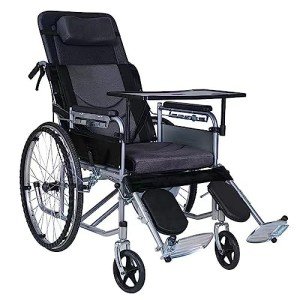Bariatric Wheelchair Seat Width
Seat Width
Having the correct seat width is crucial to wheelchair users who invest longer periods in their chairs. Too narrow a seat will cause pressure on the hips and thighs which might result in sores or pressure points. Having too broad a seat can likewise make it difficult for the user to reach the hand rims to move themselves or maneuver in little spaces.
To measure the right seat width an individual would rest on a chair normally and have their measurement taken across their lap at the best point which is usually their hips. A wheelchair determining tape can be used to measure this, but a yard stick is chosen as it avoids people from wrapping the tape around their hips which would provide an unreliable outcome.
The standard wheelchair seat width is 16" (narrow grownup), 18" (standard grownup), and 20" (wide grownup). For bariatric patients, a 24" seat is offered. This sturdy additional wide bariatric wheelchair from Medline features swing-away footrests, a carbon steel frame with rust- and chip-resistant chrome plating, and easy-to-clean vinyl upholstery. It has a weight capacity of 500 pounds.
Seat Depth
Typically, the seat depth of a bariatric wheelchair was added 2" to the measurement taken at the user's widest point (typically their hips). This was meant to accommodate additional layers of clothing that might be worn during winter. However, this practice is ending up being less typical as wheelchair users are able to invest more time indoors and are not wearing long coats. This makes the seat depth of a chair lesser when selecting a bariatric wheelchair. Nevertheless, it is still crucial to pick a choice that provides sufficient assistance for bigger users.
bariatric wheelchair weight folding additional large bariatric manual wheelchair features a comfy 24" seat width and a durable slide tube silver vein frame. It also has an adjustable axle and tool-free raising legrests.
Seat Height
When it pertains to figuring out the right wheelchair seat width you must always measure from the user's best point which is typically their hips. You will also need to consider whether the user is going to be using a winter season coat as this might add 2" to the width needed.
When a wheelchair remains in use it ought to just be operated on level surfaces with the wheel locks completely engaged. This is to prevent the chair from being able to move slopes that are 10 degrees or higher. It is likewise crucial to keep in mind that any activity that might shift the center of mass in the chair ought to be made with care. This consists of reaching for products that need the individual to lean out of their seat or trying to stand up from it.
Whenever you have the chair in use it is recommended that you frequently check it for damage and lubricate any areas that are considered needed. For example, the casters need to be lubed by eliminating the caster fork and using a multi-purpose grease to use to the caster stem bearings. Also, the foot plates can be adjusted by loosening up the bolt and then moving them to the desired position. This enables the feet to sit comfortably on the footplate and prevents any pressure points from forming. This can be really unpleasant for the user and if left unattended, can cause press sores.
Weight Capacity
Bariatric wheelchairs are developed to support more weight than basic wheelchairs. This makes them sturdier and better equipped to handle falls. They are also generally larger and wider, making them less maneuverable in tight areas than basic wheelchairs. They require lorries with special ramps and lifts to pack them, as well as motorists who know how to finest transport them from one location to the next.
When choosing a wheelchair, consider its weight capacity as it will be the primary determining consider whether it will accommodate your traveler's requirements. The weight capacity of the chair is often listed as a fixed load, meaning that it shows the quantity of weight the chair can easily hold while standing still. Nevertheless, some manufacturers likewise note an active load that is based upon a drop test and can replicate the effect of somebody taking a seat in the chair. This might be a more dependable measurement of the weight limit, depending upon your needs.
If you prepare to perform activities that shift your center of mass in the seat (such as reaching for items), be sure to have front casters pointed in a forward instructions and wheel locks engaged so the chair will not topple. Likewise, examine that casters are oiled frequently to prevent extreme wear and abrasions. The lubrication treatment involves getting rid of the fork, separating the caster from the wheel, and greasing the caster stem bearings with premium multi-purpose grease.

